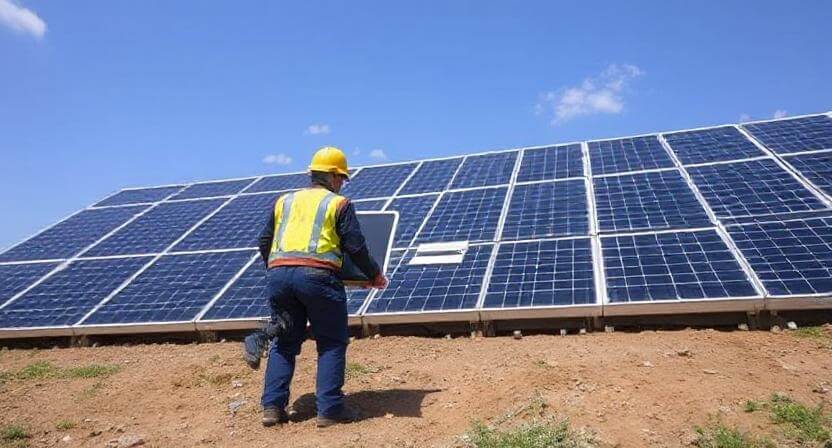Labor cost is one of the prime drivers of solar project expenses—representing as much as 30–40% of total installed cost. Meanwhile, U.S. solar generation is forecast to grow by 33–42% in 2025–2026, highlighting the imperative for strategic labor efficiency (Source).
For CXOs and business owners, reducing operational cost via targeted labor strategies is essential. Not only does it slash the levelized cost of energy (LCOE), it supports sustainable business growth, market share growth, and business continuity planning.
“Our labor budget is like a teenager’s phone battery—always draining faster than expected.”
-
The Solar Labor-Cost Equation
Labor in solar isn’t just wages: it includes onboarding, on-the-job training, safety compliance, cross training programs, talent retention, planning, and risk management. DOE defines these under “soft cost”–installing solar—now constituting a growing share of total expense
(Source).
NREL’s bottom-up cost benchmarks show labor alone accounts for 20–30% of residential and commercial PV systems, even as module prices have plummeted 82% since 2010 .
“We threw people at the problem like spaghetti at a wall—some stuck, most just made a mess.”
That’s why workforce optimization and standard operating procedures (SOPs) are critical. Reducing OpEx through labor efficiency strengthens supply chain resilience and paves the way for sustainable profit.
-
Workforce Optimization & SOPs
Deploying SOPs ensures quality installation and predictable outcomes. Trade crews follow the same checklist across sites, reducing rework and missteps. Without SOPs:
“Skipping SOPs is like letting interns drive the forklift—exciting, but probably expensive.”
Utility-scale PV installations with SOPs have trimmed Balance‑of‑System labor costs by 15%—reducing LCOE and boosting ROI
(Source).
Tracking labor metrics is key:
“Optimizing labor without metrics is like golfing blindfolded and wondering why you’re in the lake.”
Metrics like labor per kW installed and time‑to‑completion help managers spot inefficiencies and adjust SOPs accordingly.

- Training & Talent Retention
Skilled labor delivers efficiency. On-the-job training and cross training programs build versatile teams. Crews learn skills like electrical wiring, racking, or commissioning—reducing downtime when staff are absent.
“Training? We used to call it ‘learning by fire.’ Now we just call it ‘insurance.’”
Analysis suggests these labor efficiency gains could help reach DOE’s SunShot 2030 target: $0.05/kWh residential LCOE (Source).
This structured approach also strengthens talent retention—a cornerstone of business continuity planning. Employees feel valued, reducing turnover costs.
“Cross-training saved us—before that, if one guy sneezed, the whole project got the flu.”
Positioning labor as a strategic asset enhances market share growth—especially as installations scale.
- Safety Compliance as a Strategic Lever
Safety isn’t optional—it drives cost control. Proper safety compliance avoids injuries, delays, and insurance expenses. Many companies overestimate compliance costs but underestimate downtime from accidents.
“We had safety protocols, but they were more like New Year’s resolutions—great on paper, gone by February.”
Improving safety measures can reduce labor disruptions by 10–15%, bolstering risk management and reinforcing sustainable business growth.
- Supply Chain & Labor Resilience
Labor strategy must align with materials delivery. Crews without equipment—and machines waiting onsite without operators—create inefficiency.
“Our labor planning was like a buffet—too many options, not enough plates.”
Coordinated scheduling ensures materials and skilled technicians arrive in sync, avoiding wasted time and operational cost reduction.
With solar expected to hit 7–8% of U.S. electricity by 2026 (from ~5% in 2024) , these efficiencies are mission-critical.
- Cost‑Benefit Analysis & Risk Management
Before investing in tech—automation tools, training platforms, or workforce management software—do a robust cost benefit analysis.
Example: digital scheduling systems that drive a 20% efficiency increase and cut 15% OpEx may pay for themselves within 12 months. That provides justification backed by financial modeling.
“I used to think labor costs were fixed. Turns out, they’re just stubborn negotiators.”
Solid modeling helps manage labor-related risks and unlocks market share growth through competitive pricing.

- Workforce Optimization & Scalable Growth
Achieving sustainable business growth requires labor systems that scale. With 32.5 GW utility‑scale PV projected for 2025, manual approaches fall short (Source).
“We used to scale like a Jenga tower—looked fine until one wrong move brought it all down.”
Consistent SOPs, training, safety measures, and planning make scaling smooth, keeping levelized cost of energy low and operational cost reduction front and center.
- Measuring Success: Metrics Every CXO Needs
Metrics make strategy real. KPIs include:
- Labor cost per kW installed
- Time-to-completion per MW
- Turnover rate (talent retention)
- Safety incident frequency
- Number of cross-trained staff
- LCOE improvements ($/kWh)
Monthly dashboard reviews link labor improvement to business continuity and strategic decisions.
- Integrating Soft Costs & Scaling Strategies
DOE defines solar soft costs as including permitting, installation, financing, workforce—non-hardware costs now dominating the total expense (Source). Residential soft costs dropped ~50% from 2010–2020, but still need another 60–70% reduction to reach cost targets.
Cutting labor via SOPs, training, safety compliance, and workforce tools is a massive lever. Every 10% reduction in installed labor hours translates directly into lower OpEx and a significant LCOE decline on EIA benchmarks now projecting solar costs near $24–30/MWh by 2027 .
Optimizing solar labor is a strategic imperative, not an operational detail. By weaving workforce optimization, on-the-job training, cross training programs, safety compliance, and standard operating procedures into operations, companies deliver:
- Lower operational cost
- Reduced levelized cost of energy
- Enhanced market share growth
- Stronger sustainable business growth
- Better business continuity planning
- Robust supply chain resilience
- More effective risk management
Backed by hard cost benefit analysis, these changes position solar firms to scale profitably, stay competitive, and lead in an increasingly dynamic energy market.
See how FieldAx can transform your Field Operations.
Try it today! Book Demo
You are one click away from your customized FieldAx Demo!
Author Bio

Palani Kumar
Palani Kumar is a seasoned digital marketing professional with over 13 years of experience in crafting impactful strategies for B2B brands.
As the marketing lead at FieldAx, he focuses on bridging the gap between technology and business growth, simplifying complex field service management concepts into valuable insights.
Passionate about delivering informative and practical content, Palani writes about industry trends, best practices, and innovations that help businesses optimize their field operations.
When not working on marketing strategies, he enjoys exploring history, engaging in thought-provoking discussions, and appreciating the balance between technology and tradition.





